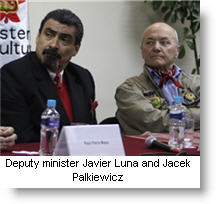Satellite images taken by the Kompsat-2 confirm the findings of a scientific expedition made 15 years ago to the source of the Amazon River —a small spring in the Apacheta gulley on Mt. Quehisha, 5150 meters above sea level in the Andes of southern Arequipa.
Confirmation of Apacheta as the source also means that the Amazon is not only the largest but the longest river in the world, around 400 kilometers (250 miles) longer than the Nile.
 The announcement was made by the president of the Sociedad Geográfica de Lima, Zaniel Novoa, together with Polish explorer Jacek Palkiewicz and the deputy minister of Cultural Heritage, Javier Luna.
The announcement was made by the president of the Sociedad Geográfica de Lima, Zaniel Novoa, together with Polish explorer Jacek Palkiewicz and the deputy minister of Cultural Heritage, Javier Luna.
A monument and plaque have been placed at the foot of Mt. Quehisha, and Novoa says that the geographical society is requesting the government to incorporate the area into the protected parks and reserves system.
There have been numerous expeditions and academic debates over the years on the source of the Amazon.
In 1971, National Geographic explorer and photographer Loren McIntyre identified the source of the Amazon as a stream on Mt. Mismi in Arequipa, from a lake now called Lake McIntyre.
 Then in 1996, Palkiewicz, a journalist and fellow of the Royal Geographic Society, led an expedition that included Novoa from the Sociedad Geográfica as well as specialists from the Peruvian Navy, Peru’s Catholic University, and the Russian Academy of Sciences. Their search led them to a small spring in the Apacheta gulley on the snow-capped Mt. Quehisha, in the province of Cailloma of Arequipa. Their findings were unquestionable, said Lima’s geographical society, and reached through appropriate scientific criteria.
Then in 1996, Palkiewicz, a journalist and fellow of the Royal Geographic Society, led an expedition that included Novoa from the Sociedad Geográfica as well as specialists from the Peruvian Navy, Peru’s Catholic University, and the Russian Academy of Sciences. Their search led them to a small spring in the Apacheta gulley on the snow-capped Mt. Quehisha, in the province of Cailloma of Arequipa. Their findings were unquestionable, said Lima’s geographical society, and reached through appropriate scientific criteria.
Later, in 2000, National Geographic followed up its earlier find with a 22-man, five-nation expedition led by math teacher and explorer Andrew Pietowski , who had explored Arequipa extensively when he led a Polish kayak expedition in the Colca Valley years earlier. The team explored the sources of the rivers that form the Amazon – the Apurimac, Huallaga, Mantaro, Marañon and Urubamba-Vilcanota – and confirmed what McIntyre had found, that the furthest source was on Mt. Mismi.
Lima’s Sociedad Geográfica never had any doubts as to the real source, and issued a press release in 2008 to back Palkiewicz’ findings.
What has led the geographical institution to yet again confirm the 1996 expedition conclusions is the series of photographs that Palkiewicz has only recently obtained, with the help of financial sponsors, from the Kompsat-2, the Korean Multiple Purpose Satellite launched in July 2006 for very high resolution images of natural resources, used for digital map-making as well as agriculture, defense, and urban planning.
According to Novoa and Palkiewicz, the images confirm that there is no stream from Lake McIntyre, and that without a doubt the spring in the Apacheta gulley is the source of the Amazon.
With Apacheta as its source, the Amazon River becomes a total of 7,040 kilometers (4374 miles) in length to the mouth on the Atlantic coast in Brazil. The River Nile is 6695 km long (4145 miles).
Coincidentally, in pre-hispanic traditions practised to this day, the word apacheta describes a small pile of stones on the roadside made by travelers as they thank the Pachamama, or mother earth, or touch the stones for a good journey.






I am pleased that the controversy surrounding the true origin of the Amazon has been authoritatively put to rest. The 1982 Cousteau Amazon Expedition, produced a documentary released to an international audience in the mid-eighties, titled “Cousteau’s Amazon”, that expedition presented this fact and at long last it can be recognized that within a rock fisher on the upper flanks of Mt, Mismi, Peru, the origin of the Amazon was first navigated by American kayaker Caril Ridley.